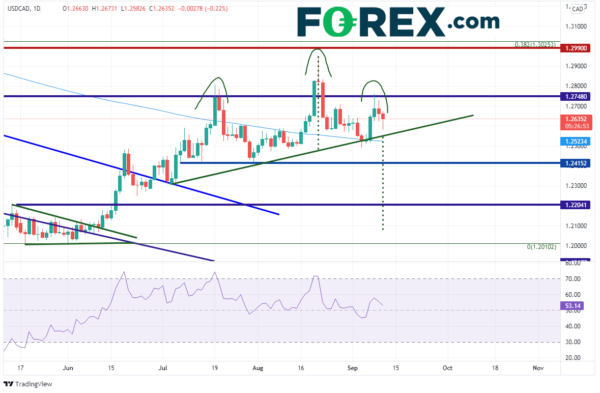Canada’s employment change for the month of August came in roughly as expected: +90,200 vs +100,000 expected. The breakdown between full-time jobs and part-time jobs had a nice distribution, with three-fourths of the jobs going to full-time positions and one-fourth to part-time positions. The unemployment rate fell to 7.1% from 7.5%, vs 7.3% expected. In addition, Average Hourly Earnings were up 1.25% (YoY) vs 0.6% in July and +0.5% expected.
After lockdowns in Canada throughout the spring, job growth has expanded 3 months in a row. However, the BOC was not ready to continue with their tapering this week, as they are still concerned about supply chain and pandemic-related risks! GDP for Q2 released on August 31st showed that GDP fell by 0.3% vs a growth of 1.4% in Q1. Yet signs are emerging of a stronger Q3, including stronger manufacturing, retail sales and now employment. In addition, inflation is running high. If this continues, taken together, this may be a reason for the BOC to taper at their next meeting.
On a daily timeframe, it appears that USD/CAD may be trying to carve out a head and shoulders formation. After failing to push through strong resistance near 1.2990, the pair formed an evening star pattern and moved lower to test the 200 Day Moving Average and the potential neckline of the pattern near 1.2525. The pair bounced to resistance and may currently be forming the right shoulder of the pattern. However, the neckline and the 200 Day Moving Average offer support between 1.2523 and 1.2550.
Source: Tradingview, Stone X
In addition, on a 240-minute timeframe, there is a strong support zone between 1.2500 and 1.2600. 1.2591 is also the 38.2% Fibonacci retracement from the June 1st lows to the August 20th highs. If price can manage to break through 1.2500, the next support level is 1.2415. Below there, USD/CAD can fall to horizontal support near 1.2200. The target for the head and shoulders pattern is near 1.2100!
Source: Tradingview, Stone X
If USD/CAD can manage to hold the 1.2500 level, resistance is at the September 8th highs near 1.2760, the August 20th highs at 1.2952 and the long-term horizontal resistance near 1.2990.
With a string of positive jobs data from Canada, the BOC may feel like they are in a better position to continue with their tapering at the next meeting. Add in strong manufacturing and retail sales, and it makes their case even stronger. This could cause USD/CAD to move lower. However, there is a good deal of support between 1.2500 and 1.2600 that price must get through first!


 Signal2forex.com - Best Forex robots and signals
Signal2forex.com - Best Forex robots and signals




